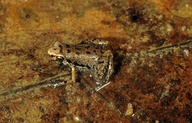|
Description
A small terrestrial microhylid, males 14-16 mm. Colouration is variable. Back
is greyish, and sometimes nearly uniformly coloured, generally with
symmetrical black patches which can fuse to a teddy-bear shaped black marking.
Tympanic region often with a whitish patch. Skin on the back is smooth.
Tympanum is indistinct. Tibiotarsal articulation reaches the eye. Four
fingers and 5 toes, without digital reduction. Males with a distinct,
largely distensible, single subgular vocal sac (Glaw and Vences 1994).
Call is completely different from all other known Stumpffia calls. A
single note, consists of a pulsed (about 13-14 pulses) trill. Calls are
arranged in series, which can last several minutes. Call duration is
700-730 ms, intervals between calls last 1700-2000 ms, call repetition rate is
about 30/min, and frequency between 4.7 and 5 kHz (Glaw and Vences 1994).
Most other species of Stumpffia show digital reduction and have a
different call. The skin of Stumpffia gimmeli is more granular, and
its call and colouration are different (Glaw and Vences 1994). Distribution and Habitat
Country distribution from AmphibiaWeb's database: Madagascar
Species is reliably known from Nosy Be, Nosy Sakatia, Lokobe, Benavony (Glaw and Vences 2007). It occurs from sea level up to 700m asl (Andreone and Raxworthy 2008).Life History, Abundance, Activity, and Special Behaviors
Males call mainly at dusk when it is raining, sometimes also during day and night, from the leaf litter in primary and secondary forest, rarely even under single trees outside the forest. The species occurs sympatrically with
Stumpffia pygmaea at Nosy Be and with Stumpffia gimmeli at
Benavony (Glaw and Vences 1994). Trends and Threats
Species is listed as data deficient in view of continuing uncertainties as to its taxonomic status, extent of occurrence and ecological requirements. It occurs in the Réserve Naturelle Intégrale de Lokobe and the Réserve Spéciale de Manongarivo. However, its forest habitat is receding due to subsistence agriculture, timber extraction, charcoal manufacture, invasive spread of eucalyptus, livestock grazing, fire and expanding human settlements (Andreone and Raxworthy 2008). Possible reasons for amphibian decline General habitat alteration and loss
Habitat modification from deforestation, or logging related activities
Intensified agriculture or grazing
Urbanization
Subtle changes to necessary specialized habitat
Comments
Taken with permission from Glaw and Vences (1994, 2007) and Andreone and Raxworthy (2008).
References
Andreone, F. and Raxworthy, C. (2008). Stumpffia psologlossa. In: IUCN 2008. 2008 IUCN Red List of Threatened Species. www.iucnredlist.org. Downloaded on 22 April 2009.
Glaw, F. and Vences, M. (1994). Amphibians and Reptiles of Madagascar. M. Vences and F. Glaw Verlags GbR., Köln.
Glaw, F., and Vences, M. (2007). Field Guide to the Amphibians and Reptiles of Madagascar. Third Edition. Vences and Glaw Verlag, Köln.
Originally submitted by: Miguel Vences and Frank Glaw (first posted 2001-10-29)
Edited by: Catherine Aguilar (2010-07-19)Species Account Citation: AmphibiaWeb 2010 Stumpffia psologlossa <https://amphibiaweb.org/species/2363> University of California, Berkeley, CA, USA. Accessed May 30, 2025.
Feedback or comments about this page.
Citation: AmphibiaWeb. 2025. <https://amphibiaweb.org> University of California, Berkeley, CA, USA. Accessed 30 May 2025.
AmphibiaWeb's policy on data use.
|
